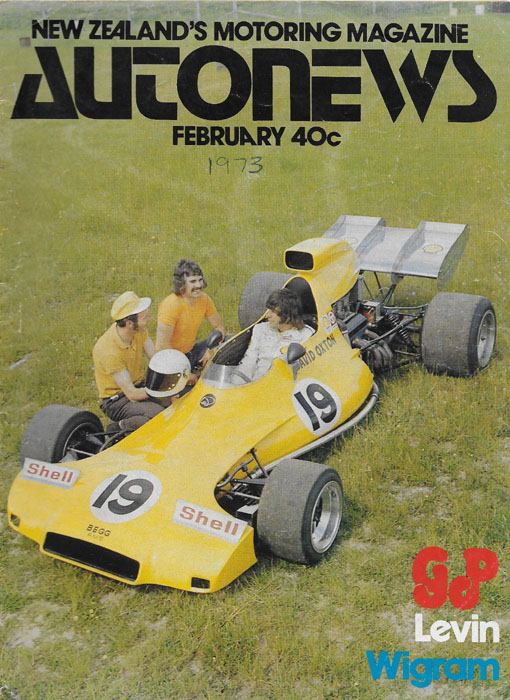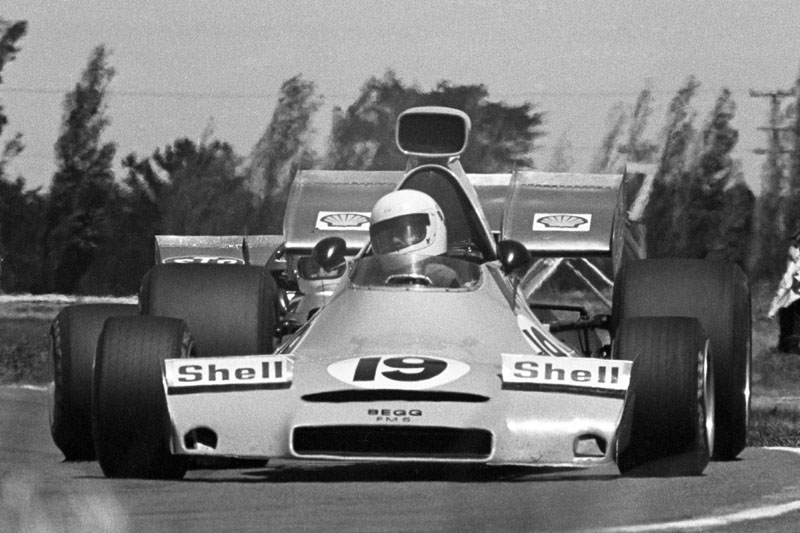-
Administrator


Pukekohe played host to the 1973 New Zealand Grand Prix, and the big field featured a star-studded cast of the worlds best Formula 5000 teams. The McRae GM1 was the car to have in 1972/73, and apart from McRae himself, Alan Rollinson, Evan Noyes, and Dexter Dunlop were all entered in customer cars. Australian driver/engineer Frank Matich appeared in a car of his own design, the Match A50, while Max Stewart, Warwick Brown, and Kevin Bartlett all had the latest wedge-shaped Lola 300, with its radical hip-mounted radiators, breaking away from the traditional nose mounted radiator design. John McCormack was entered in the impressive Australian built Elfin MR5.
Oxton, in just the Begg FM5s fifth race, qualified an impressive seventh, but was effectively eliminated when he and Frank Radisich collided in race morning practice. The team scrambled to make repairs before the race started, but the rest of the grid had already completed two laps before the yellow Begg barked into life and took off in pursuit. Alas, that pursuit would last just five laps before Oxton clunked one of the new Pukekohe chicanes, and retired.
Round 2 was held at Levin, and again, Oxton in the Begg would be the fastest of the local contingent, qualifying eighth. After 63 laps, he finished an impressive fifth. On to Wigram, for the coveted Lady Wigram Trophy, and once again Oxton was eighth in qualifying, before taking another fifth in the race. The final New Zealand leg of the Tasman Series was held at Teretonga, the Begg teams home race, and Oxton gave the enthusiastic local crowd something to cheer about, by qualifying seventh.
Just prior to race start, rain began to fall, and the little Begg team, who’d opted to run slick tyres, had no chance of switching to wets. Following a spin which dropped him down the field, Oxton pitted to change tyres, and after rotating the car again later in the race, wound up in ninth place at the finish.
George Begg had made an arrangement with Australian Lola driver Kevin Bartlett to organise his transport within New Zealand for the local Tasman Series races, with Bartlett doing the same for the Begg team for the four Australian rounds of the series. However, when plans to get the car and spares to Australia faltered, the Begg team was scratched. But George Begg, excited by the potential of his new steed, now had ambitions that extended far beyond Australia.
Back in September 1972, Begg had flown to England following an invite from Graham McRae, who asked him if he’d be interested in running the McRae factory, in Poole, Dorset. Begg had already worked a stint at McLaren in 1968, and was initially enthusiastic about the prospect of running the McRae operation. But upon closer inspection, he opted not to proceed. However, having taken in F5000 races in both the UK and US before returning home, Begg began hatching a plan to take his little team to England, to contest selected rounds of the Rothmans European Formula 5000 Championship.
The Begg team that competed in the European championship comprised an even smaller line-up than that which raced in New Zealand, and included Oxton, Begg himself, and Joe Wright, a New Zealand international race mechanic who had been working for McRae. Oxton had already competed on many of the British race tracks during his Formula Ford days.

The Begg FM5, plus two spares engines and a container load of other parts, departed New Zealand in February 1973, and arrived in England one month later where the team had by now set up a temporary workshop in a disused factory in the small town of Earls Barton. They’d miss the opening round of the championship, held on 17 March, but would make Round 2, held at Mallory Park on 1 April. Qualifying was held on the Sunday morning of the race, with the race itself in the afternoon. Oxton began circulating in the difficult wet conditions of the first session, before the track dried for the second. However, an engine issue slowed his progress, and he qualified fourteenth, before the team made the decision to withdraw from the race, as they couldn’t change the engine in time.
The next event was the GKN-Daily Express Silver Jubilee International Trophy, held at Silverstone. This event had been running since 1949, and in 1972, the organisers arranged a headline act, pitting the top Formula 5000 cars against Formula 1 cars. This proved a popular addition to the format, and was repeated again in 1973. In addition, the F5000s would get their own 25 lap race as part of their championship. Of the Begg FM5, all the way from New Zealand, the event programme read; ‘From New Zealand comes the interesting Begg FM5 Chevrolet driven by their champion driver, 26-year old David Oxton. From Drummond, Invercargill, the Begg is the hobby of George Begg whose business is the manufacturer of agriculture equipment for the farming industry. Long, low and sleek, it is a thoroughly professional machine – far from agricultural’.
In qualifying on the high-speed Silverstone layout, the Begg’s nose began to crack from the heavy loads being applied to it. The team attached sections of aluminium to add strength, and Oxton went out and qualified twelfth fastest. In the race, held on Saturday, despite the tyres not working as he would have liked, Oxton climbed right through the field to finish an impressive fifth, behind three of the latest Lola T330s, and a Chevron B24. Understandably, the tiny New Zealand team were overjoyed.
 Posting Permissions
Posting Permissions
- You may not post new threads
- You may not post replies
- You may not post attachments
- You may not edit your posts
-
Forum Rules






 Reply With Quote
Reply With Quote